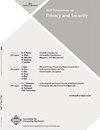Lightbox:基于光谱指纹的光电传感器攻击检测
IF 2.8
4区 计算机科学
Q2 COMPUTER SCIENCE, INFORMATION SYSTEMS
引用次数: 0
摘要
光电传感器用于一系列安全关键应用,如医疗设备和自动驾驶汽车。然而,光电传感器输入通道的公开暴露使其容易受到恶意输入。一些研究已经提出了通过注入恶意信号来攻击光电传感器的可能性。虽然针对此类攻击已经提出了一些防御技术,但它们要么可以被绕过,要么用于有限的目的。在这项研究中,我们提出了一种基于信号指纹的新型防御系统Lightbox,用于检测对光电传感器的传感器攻击。Lightbox使用接收光的光谱作为特征来区分攻击者的恶意信号和真实信号,真实信号是来自传感器光源的信号。我们针对以下情况对Lightbox进行了评估:1)饱和攻击者,2)简单的欺骗攻击者,以及3)了解Lightbox并可以组合多个光源来模拟真实光源的复杂攻击者。Lightbox对饱和攻击者和简单欺骗攻击者的总体准确率超过99%,对复杂攻击者的鲁棒性。我们还对Lightbox进行了评估,考虑了各种环境,如传输介质、背景噪声和输入波形。最后,在进一步缩短训练时间后,我们利用单板计算机进行了实验,证明了Lightbox的实用性。本文章由计算机程序翻译,如有差异,请以英文原文为准。
Lightbox: Sensor Attack Detection for Photoelectric Sensors via Spectrum Fingerprinting
Photoelectric sensors are utilized in a range of safety-critical applications, such as medical devices and autonomous vehicles. However, the public exposure of the input channel of a photoelectric sensor makes it vulnerable to malicious inputs. Several studies have suggested possible attacks on photoelectric sensors by injecting malicious signals. While a few defense techniques have been proposed against such attacks, they could be either bypassed or used for limited purposes. In this study, we propose Lightbox, a novel defense system to detect sensor attacks on photoelectric sensors based on signal fingerprinting. Lightbox uses the spectrum of the received light as a feature to distinguish the attacker’s malicious signals from the authentic signal, which is a signal from the sensor’s light source. We evaluated Lightbox against 1) a saturation attacker, 2) a simple spoofing attacker, and 3) a sophisticated attacker who is aware of Lightbox and can combine multiple light sources to mimic the authentic light source. Lightbox achieved the overall accuracy over 99% for the saturation attacker and simple spoofing attacker, and robustness against a sophisticated attacker. We also evaluated Lightbox considering various environments such as transmission medium, background noise, and input waveform. Finally, we demonstrate the practicality of Lightbox with experiments using a single-board computer after further reducing the training time.
求助全文
通过发布文献求助,成功后即可免费获取论文全文。
去求助
来源期刊

ACM Transactions on Privacy and Security
Computer Science-General Computer Science
CiteScore
5.20
自引率
0.00%
发文量
52
期刊介绍:
ACM Transactions on Privacy and Security (TOPS) (formerly known as TISSEC) publishes high-quality research results in the fields of information and system security and privacy. Studies addressing all aspects of these fields are welcomed, ranging from technologies, to systems and applications, to the crafting of policies.
 求助内容:
求助内容: 应助结果提醒方式:
应助结果提醒方式:


